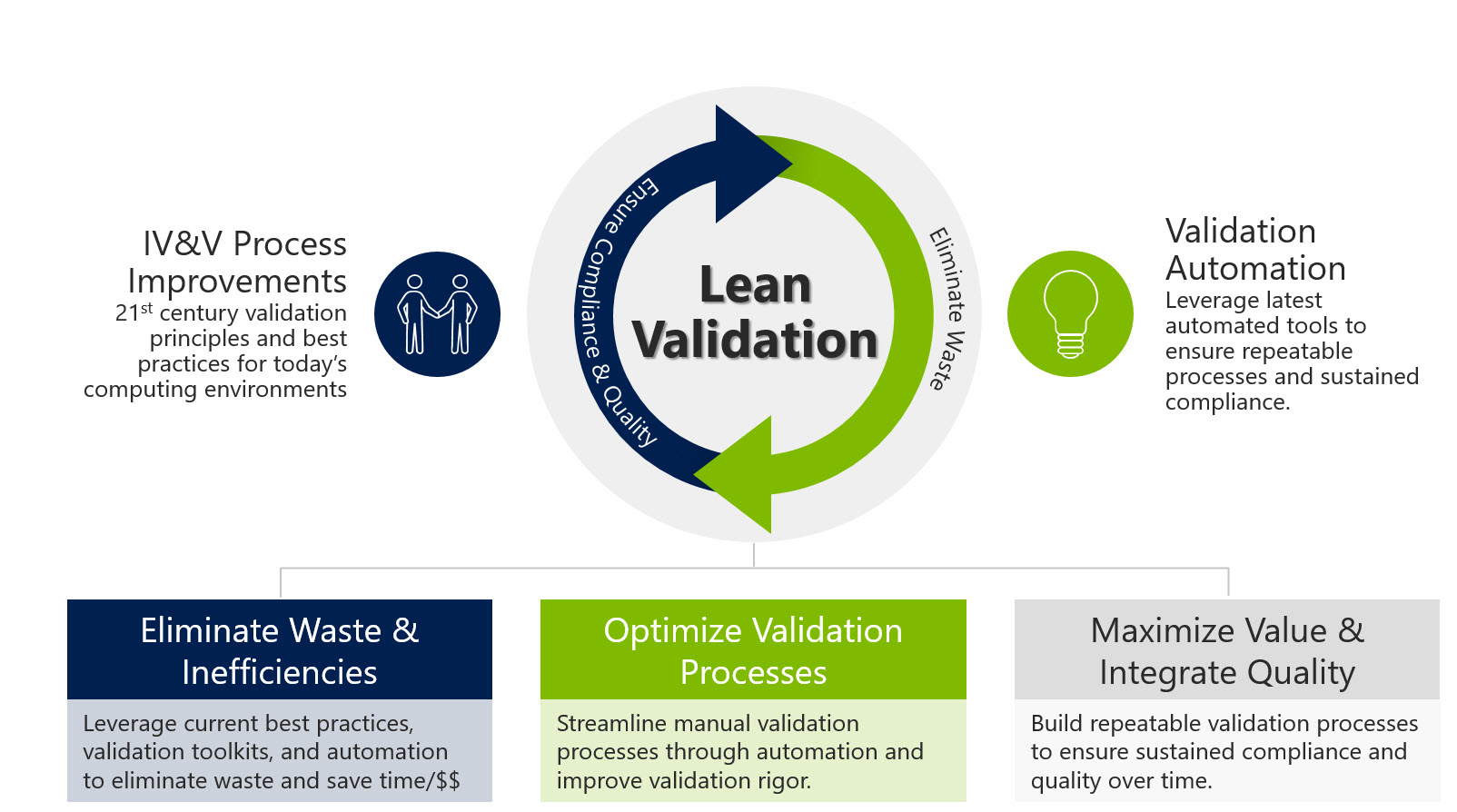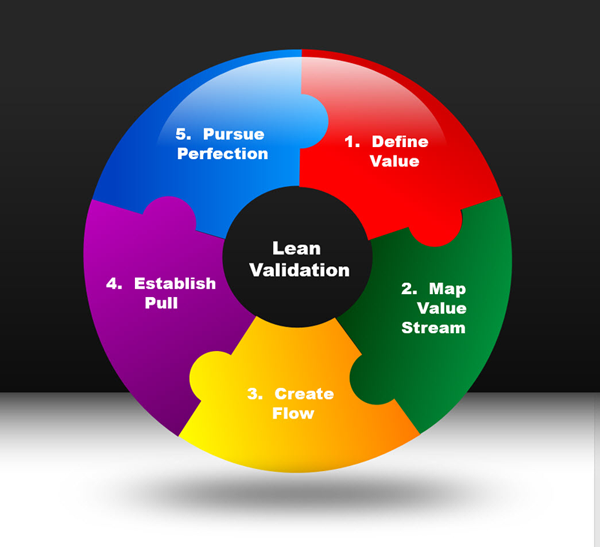The principles and best practices of lean manufacturing have served life sciences manufacturers well. Lean is all about optimizing processes, while eliminating waste (“Muda”) and driving greater efficiencies. As a 30-year validation practitioner, I have validated many computer systems, equipment and processes. One of the key lessons learned is that there is much room for improvement across the validation process.
OnShore Technology Group, Inc. is a pioneer in lean validation and has developed principles and best practices to support lean validation processes. To power our lean processes, we leverage ValidationMaster™, an Enterprise Validation Management system exclusively designed to facilitate lean validation and automate the validation process.
So what is lean validation and how is it practically used?
Lean validation is the process of eliminating waste and inefficiencies while driving greater software quality across the validation process through automation.

Lean validation cannot be achieved without automation. Lean validation processes leverage advanced technology designed to fulfill the technical, business and compliance requirements for software validation eliminating the use of manual, paper-based processes. Optimized validation processes are deployed using the latest global best practices to ensure the right amount of validation rigor based on critical quality attributes, risks, Cybersecurity and other factors.
Lean validation process begins with a lean validation project charter which defines the description of the process and key performance indicators. KPI’s such as reduce validation costs by $X/year or reduce software errors by X%. The charter shall define the project scope, dependencies, project metrics and resources for the project.
There are five principles of lean validation derived from lean manufacturing principles. Lean validation is powered through people, processes and technology. Automation drives lean validation processes. The LEAN VALIDATION value principles are illustrated in the figure below.

Principle 1 – VALUE – Lean thinking in manufacturing begins with a detailed understanding of what value the customer assigns to product and services. Lean thinking from an independent validation and verification perspective begins with a detailed understanding of the goals and objectives of the validation process and its adherence to compliance objectives. The principle of VALUE requires the validation team to therefore focus on the elimination of waste to deliver the value the end customer (your organization) in the most cost-effective manner. The computer systems validation process is designed for the purpose of assuring that software applications meet their intended use. The value derived from the validation process is greater software quality, enhanced ability to identify software defects as a result of greater focus and elimination of inefficient and wasteful processes. AUTOMATION IS THE FOUNDATION THAT FACILITATES THE ACHIEVEMENT OF THIS VALUE PRINCIPLE.
Principle 2 – VALUE STREAM – The value stream, from a lean perspective is the comprehensive product life-cycle from the raw materials through customer’s end use, and ultimate disposal the product. To effectively eliminate waste, the ultimate goal of lean validation, there must be an accurate and complete understanding of the value stream. Validation processes must be examined end-to-end to determine what value is added to the objective of establishing software quality and compliance. Any process that does not add value to the validation process should be eliminated. We recommend value stream mapping for the validation process to understand where value is added and where non-value added processes can be eliminated. Typical “Muda” or wastes commonly revealed from validation process mapping are:
- Wasteful Legacy Processes (“we have always done it this way”)
- Processes That Provide No Value To Software Quality At All
- Manual Process Bottlenecks That Stifle Processes
Principle 3 – FLOW – The lean manufacturing principle of flow is about creating a value chain with no interruption in the production process and a state where each activity is fully in step with every other. A comprehensive assessment and understanding of flow throughout the validation process is essential to the elimination of waste. From a validation perspective, optimal flow is created through the process when, for example, users have the ability to automatically create requirements from test scripts for automated traceability thereby eliminating the process of manually tracing each test script to a requirement. Another example is when a user has the ability to navigate through a software application and the test script process is automatically generated. Once generated, it is automatically published to a document portal where it is routed electronically for review and approval. All of this requires AUTOMATION to achieve the principle of FLOW. For process optimization and quality control throughout the validation lifecycle, information should optimally flow throughout the validation process in an efficient manner minimizing process and document bottlenecks with traceability throughout the process.
Principle 4 – PULL – A pull system is a lean manufacturing is used to reduce waste in the production process. Components used in the manufacturing process are only replaced once they have been consumed so companies only make enough products to meet customer demand. There is much waste in the validation process. The PULL strategy for validation may be used to reduce wastes such as duplication of effort, streamlining test case development and execution, electronic signature routing/approval and many others. Check out our blog “The Validation Post” for more information.
Principle 5 – PERFECTION – Validation processes are in constant pursuit of continuous improvement. Automation is KEY. Lean validation engineers and quality professional relentlessly drive for perfection. Step by step validation engineers must identify root causes of software issues, anomalies, and quality problems that affect the suitability of a system for production use. As computing systems environments evolve and become more complex and integrated, validation engineers must seek new, innovative ways to verify software quality and compliance in today’s advanced systems. Perfection cannot easily be achieved through manual processes.
AUTOMATION IS REQUIRED TO TRULY REALIZE THE VISION OF THIS PRINCIPLE.
You can save time and money through lean. Consider the first 2 principles of Value and Value Stream. Many validation engineers consider validation only as a regulatory requirement or “necessary evil” – rather than a regulatory best practice designed to save time and money. I think we all agree that in the long run quality software saves time and money through regulatory cost avoidance and more efficiency throughout quality processes.
It is important for validation engineers to not only consider quality and compliance but cost savings that may be gained throughout the validation process. Lean validation is a strategy whose time has come. How much will cost savings be through lean? End users report saving about 40 – 60% for test script development and 60 – 70% on regression testing efforts. Regulatory cost avoidance can be significant depending on the level of compliance with each company. Cost savings may also be realized in minimizing the amount of paper generated through the validation process.
Embrace LEAN VALIDATION and experience the benefits of saving time and money.







